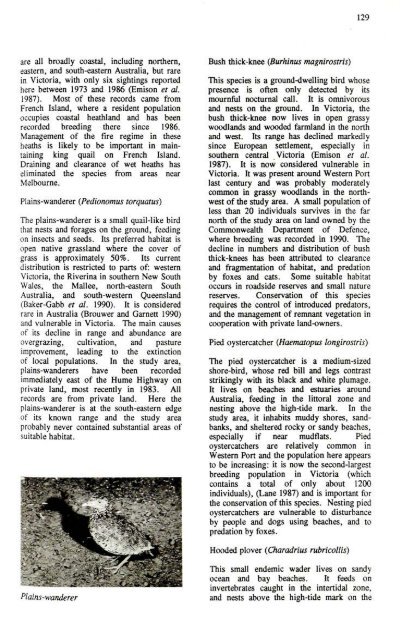Factors Affecting Flora Conservation - Victorian Environmental ...
Factors Affecting Flora Conservation - Victorian Environmental ...
Factors Affecting Flora Conservation - Victorian Environmental ...
You also want an ePaper? Increase the reach of your titles
YUMPU automatically turns print PDFs into web optimized ePapers that Google loves.
129<br />
are all broadly coastal, including northern,<br />
eastem, and south-eastern Ausfralia, but rare<br />
in Victoria, with only six sightings reported<br />
here between 1973 and 1986 (Emison et al,<br />
1987). Most of these records came from<br />
French Island, where a resident populafion<br />
occupies coastal heathland and has been<br />
recorded breeding there since 1986.<br />
Management of the fire regime in these<br />
heaths is likely to be important in maintaining<br />
king quail on French Island.<br />
Draining and clearance of wet headis has<br />
eliminated the species from areas near<br />
Melbourne.<br />
PI ains-wanderer (Pedionomus torquatus)<br />
The plains-wanderer is a small quail-like bird<br />
that nests and forages on the ground, feeding<br />
on insects and seeds. Its preferted habitat is<br />
open native grassland where the cover of<br />
grass is approximately 50%. Its current<br />
distribution is restrict^ to parts of: western<br />
Victoria, the Riverina in southern New South<br />
Wales, the Mallee, north-eastern South<br />
Australia, and south-western Queensland<br />
(Baker-Gabb et al. 1990). It is considered<br />
rare in Australia (Brouwer and Garnett 1990)<br />
and vulnerable in Victoria. The main causes<br />
of its decline in range and abundance are<br />
overgrazing, cultivation, and pasture<br />
improvement, leading to the extinction<br />
of local populations. In the study area,<br />
pi ains-wanderers have been recorded<br />
immediately east of the Hume Highway on<br />
private land, most recently in 1983. All<br />
records are from private land. Here the<br />
pi ains-wanderer is at the south-eastern edge<br />
of its known range and the study area<br />
probably never contained substantial areas of<br />
suitable habitat.<br />
Bush thick-knee (Burhinus magnirostris)<br />
This species is a ground-dwelling bird whose<br />
presence is often only detected by its<br />
mournful nocturnal call. It is omnivorous<br />
and nests on the ground. In Victoria, the<br />
bush thick-knee now lives in open grassy<br />
woodlands and wooded farmland in the north<br />
and west. Its range has declined markedly<br />
since European setflement, especially in<br />
southern cenfral Victoria (Emison et al.<br />
1987). It is now considered vulnerable in<br />
Victoria. It was present around Western Port<br />
last century and was probably moderately<br />
common in grassy wocxllands in the northwest<br />
of the study area. A small population of<br />
less than 20 individuals survives in the far<br />
north of the study area on land owned by the<br />
Commonwealth Department of Defence,<br />
where breeding was recorded in 1990. The<br />
decline in numbers and distribution of bush<br />
thick-knees has been attributed to clearance<br />
and fragmentation of habitat, and predation<br />
by foxes and cats. Some suitable habitat<br />
occurs in roadside reserves and small nature<br />
reserves. <strong>Conservation</strong> of this species<br />
requires the confrol of introduced predators,<br />
and the management of renmant vegetation in<br />
cooperation with private land-owners.<br />
Pied oystercatcher (Haematopus longirostris)<br />
The pied oystercatcher is a medium-sized<br />
shore-bird, whose red bUI and legs contrast<br />
sfrikingly with its black and white plumage.<br />
It lives on beaches and estuaries around<br />
Ausfralia, feeding in the littoral zone and<br />
nesting above the high-tide mark. In the<br />
study area, it inhabits muddy shores, sandbanks,<br />
and sheltered rocky or sandy beaches,<br />
especially if near mudflats. Pied<br />
oystercatchers are relatively common in<br />
Westem Port and the population here appears<br />
to be increasing: it is now the second-largest<br />
breeding population in Victoria (which<br />
contains a total of only about 1200<br />
individuals), (Lane 1987) and is important for<br />
the conservation of this species. Nesting pied<br />
oystercatchers are vulnerable to distiubance<br />
by people and dogs using beaches, and to<br />
predation by foxes.<br />
Hooded plover (Charadrius rubricollis)<br />
Plains-wanderer<br />
This small endemic wader lives on sandy<br />
ocean and bay beaches. It feeds on<br />
invertebrates caught in the intertidal zone,<br />
and nests above die high-tide mark on the
















